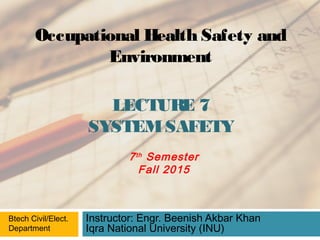Lecture 7
- 1. LECTURE 7 SYSTEMSAFETY Instructor: Engr. Beenish Akbar Khan Iqra National University (INU) Occupational Health Safety and Environment Btech Civil/Elect. Department 7th Semester Fall 2015
- 2. As society becomes more technically advanced, its tools become more and more sophisticated. In some cases, the machine has advanced further than the human capacity to control it. Jet fighters are good examples. Safety professionals need to be aware of the limits of human performance. 2
- 3. The system life cycle consists of six phases: 1.Concept 2.Definition 3.Development 4.Production 5.Deployment and 6.Disposition At the end of each phase, a safety review is conducted. A decision is then made whether to continue the project or place it on hold, pending further examination. 3
- 4. Historical data and technical forecasts are developed for a system hazard analysis. A Preliminary Hazard Analysis (PHA) is conducted during this phase. Risk Analysis (RA) is performed to determine hazard control and to develop system-safety criteria. Safety management will be doing the initial work on the System Safety Program Plan (SSPP). Three basic questions must be answered by the time the concept phase is completed: ï§ââHave the hazards associated with the design concept been discovered and evaluated to establish hazard controls? ï§Have risk analyses been initiated to establish the means for hazard control? ï§Are initial safety requirements established for the concept phase?ââ (Roland and Moriarty, 1990, p. 23). 4
- 5. Definition phase is used to verify the preliminary design and product engineering. Reports presented at design review meetings discuss the technological risks, costs, human engineering, operational and maintenance suitability, and safety aspects. In addition subsystems, assemblies, and subassemblies of the system are defined at this time. The PHA is updated and a Subsystem Hazard Analysis (SSHA) is initiated so it can later be integrated into the System Hazard Analysis (SHA). Safety analysis techniques are used during this phase to identify safety equipment, specification of safety design requirements, initial development of safety test plans and requirements, and prototype testing to verify the type of design selected. 5
- 6. Environmental impact, integrated logistics support, producible engineering, and operational use studies are done during the development phase. The SSHA and safety design criteria are also completed during this phase. Using the data collected, a go/no-go decision can be made before production begins. 6
- 7. The production phase of the system life cycle involves close monitoring by the safety department. In addition, the quality- control department becomes important because of its focus on inspection and testing of the new product. Training begins during this phase. Updating of the analyses started during the definition and development phases continues. Finally, all the information collected during this phase is compiled into the System Safety Engineering Report (SSER). The SSER identifies and documents the hazards of the final product. 7
- 8. When the system becomes operational, it is in the deployment phase. Data continues to be collected and training is conducted. If any problems occur, individuals responsible for system safety must be available to follow up and decide on possible solutions. The system safety group in the organization also reviews any design changes made on the system. A sixth phase of the system life cycle, the disposition or termination phase, is the time that a system is removed from service. A good example is asbestos removal from a building. Safety professionals monitor these situations so both the worker and the public are protected. 8








